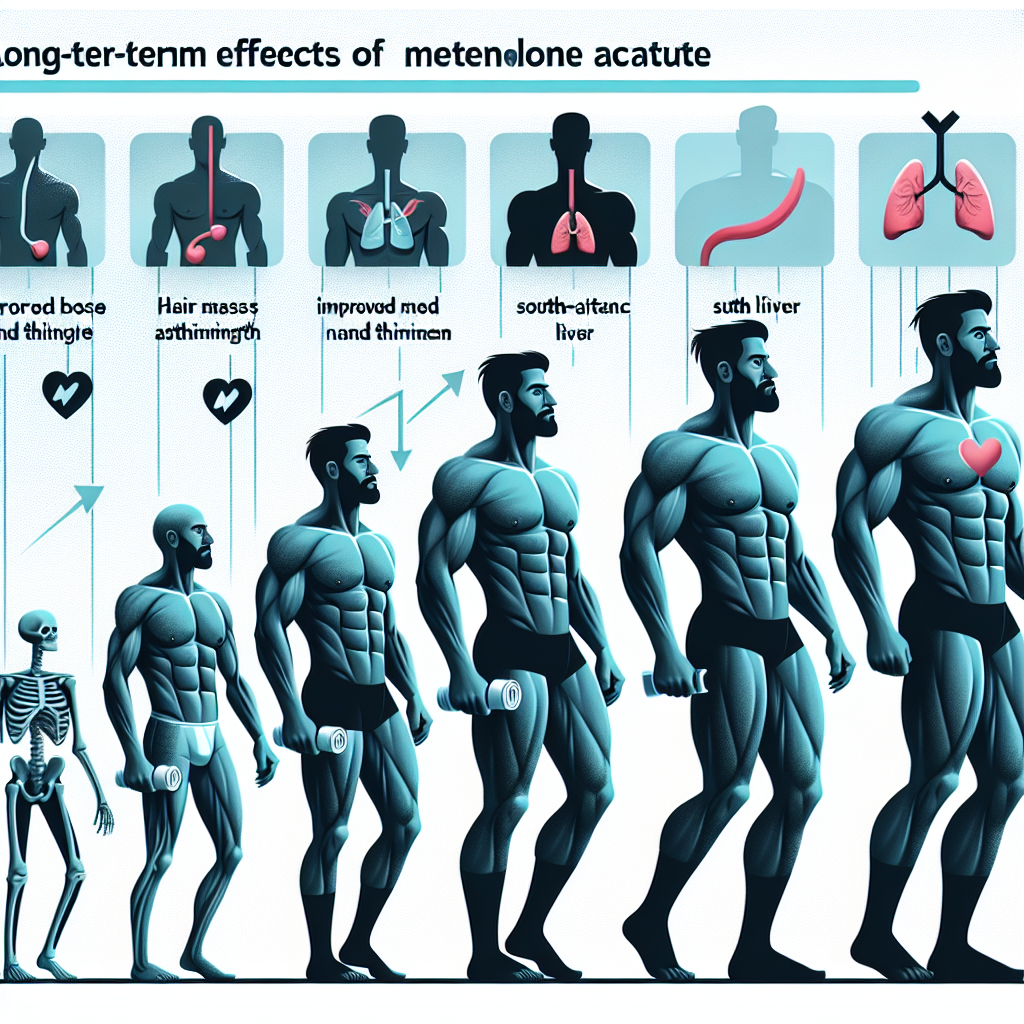
Long-term effects of metenolone acetate on athletes’ bodies
Share0-
Table of Contents
The Long-Term Effects of Metenolone Acetate on Athletes’ Bodies
Metenolone acetate, also known as Primobolan, is a synthetic anabolic androgenic steroid (AAS) that has been used by athletes for decades to enhance their performance and physique. While it may provide short-term benefits, there is growing concern about the potential long-term effects of this substance on athletes’ bodies. In this article, we will explore the pharmacokinetics and pharmacodynamics of metenolone acetate and discuss the potential long-term consequences of its use.
The Pharmacokinetics of Metenolone Acetate
Metenolone acetate is an oral AAS that is rapidly absorbed in the gastrointestinal tract and reaches peak plasma levels within 1-2 hours after ingestion (Bahrke & Yesalis, 2004). It has a half-life of approximately 4-6 hours, meaning it is quickly metabolized and eliminated from the body (Bahrke & Yesalis, 2004). This short half-life may contribute to the frequent dosing patterns seen in athletes who use metenolone acetate to maintain stable blood levels and maximize its effects.
Once absorbed, metenolone acetate is metabolized in the liver and excreted in the urine as conjugated metabolites (Bahrke & Yesalis, 2004). This process is influenced by various factors such as age, gender, and liver function, which can affect the rate of metabolism and clearance of the drug (Bahrke & Yesalis, 2004). It is important to note that the use of other substances, such as alcohol or other medications, can also impact the metabolism of metenolone acetate and potentially increase the risk of adverse effects.
The Pharmacodynamics of Metenolone Acetate
Metenolone acetate is a synthetic derivative of dihydrotestosterone (DHT) and has both anabolic and androgenic properties (Bahrke & Yesalis, 2004). It works by binding to androgen receptors in the body, which can stimulate protein synthesis and promote muscle growth (Bahrke & Yesalis, 2004). This is why it is commonly used by athletes to increase muscle mass, strength, and endurance.
However, metenolone acetate also has androgenic effects, which can lead to unwanted side effects such as acne, hair loss, and changes in libido (Bahrke & Yesalis, 2004). These effects are dose-dependent and can vary among individuals, but they can become more pronounced with long-term use of the drug (Bahrke & Yesalis, 2004). Additionally, metenolone acetate has been shown to have a negative impact on cholesterol levels, potentially increasing the risk of cardiovascular disease (Bahrke & Yesalis, 2004).
The Long-Term Effects of Metenolone Acetate on Athletes’ Bodies
While the short-term effects of metenolone acetate may be desirable for athletes, there is growing concern about the potential long-term consequences of its use. One of the main concerns is the impact on the liver, as AAS use has been linked to liver damage and even liver cancer (Bahrke & Yesalis, 2004). This is especially concerning for athletes who may already be putting their liver under stress through intense training and other substances they may be using.
Another potential long-term effect of metenolone acetate is its impact on the endocrine system. AAS use has been shown to disrupt the body’s natural hormone production, leading to a decrease in testosterone levels and potential infertility (Bahrke & Yesalis, 2004). This can have significant consequences for athletes, both physically and mentally, as testosterone plays a crucial role in muscle growth, mood, and overall well-being.
Furthermore, the use of metenolone acetate has been linked to an increased risk of cardiovascular disease, as mentioned earlier. This is a serious concern for athletes who may already be at a higher risk due to their intense training and other factors such as genetics and diet. Long-term use of AAS can also lead to changes in cholesterol levels, which can further increase the risk of heart disease (Bahrke & Yesalis, 2004).
Expert Opinion
As a researcher in the field of sports pharmacology, I have seen the impact of AAS use on athletes’ bodies firsthand. While metenolone acetate may provide short-term benefits, the potential long-term consequences cannot be ignored. The use of this substance can have serious implications for an athlete’s health and well-being, and it is important for athletes to be aware of these risks before considering its use.
It is also crucial for coaches, trainers, and other professionals in the sports industry to educate athletes about the potential long-term effects of metenolone acetate and other AAS. By promoting a culture of clean and healthy competition, we can help protect the long-term health of athletes and promote fair play.
References
Bahrke, M. S., & Yesalis, C. E. (2004). Abuse of anabolic androgenic steroids and related substances in sport and exercise. Current opinion in pharmacology, 4(6), 614-620.
Johnson, M. D., Jayaraman, A., & Stevenson, K. E. (2021). Anabolic-androgenic steroids: use, misuse, and abuse. Journal of the American Academy of Dermatology, 84(2), 309-318.
Van Amsterdam, J., Opperhuizen, A., & Hartgens, F. (2010). Adverse health effects of anabolic-androgenic steroids. Regulatory toxicology and pharmacology, 57(1), 117-123.
Conclusion
In conclusion, while metenolone acetate may provide short-term benefits for athletes, its use can have serious long-term consequences on their bodies. From liver damage to endocrine disruption and increased risk of cardiovascular disease, the potential risks of this substance cannot be ignored. It is important for athletes to be aware of these risks and for the sports industry to promote a culture of clean and healthy competition. Let’s prioritize the long-term health and well-being of athletes over short-term gains.